Abstract
The purpose of this study was to test the hypothesis that oral administration of a low dose of practolol in man produces selective beta-1 receptor blockade, whereas oral administration of a high dose blocks both beta-1 and beta-2 receptors. Normal men were studied 2-4 h after a single oral dose of practolol (1.5 or 12 mg/kg) and after placebo. Effects on beta-1 receptors were studied by measuring heart rate responses to exercise. Effects on beta-2 receptors were tested by measuring forearm vascular responses to brachial arterial infusions of isoproterenol. Neither dose of practolol altered base-line heart rate, forearm vascular resistance, and arterial pressure, Both low and high doses significantly attenuated heart rate responses to exercise. Forearm vasodilator responses to isoproterenol were attenuated by the high dose, but not the low dose, of practolol. Serum concentrations of practolol 2 h after administration of the drug and at the time of the studies of forearm vascular responses averaged 0.5+/-0.1 (SE) and 5.9+/-1.0 mug/ml for low and high doses of practolol, respectively. The results indicate that the phenomenon of selective beta-1 receptor blockade in man is related to the dose and serum concentration of practolol selectively block beta-1 receptors; a high dose and serum concentrations block both beta-1 and beta-2 receptors.
Full text
PDF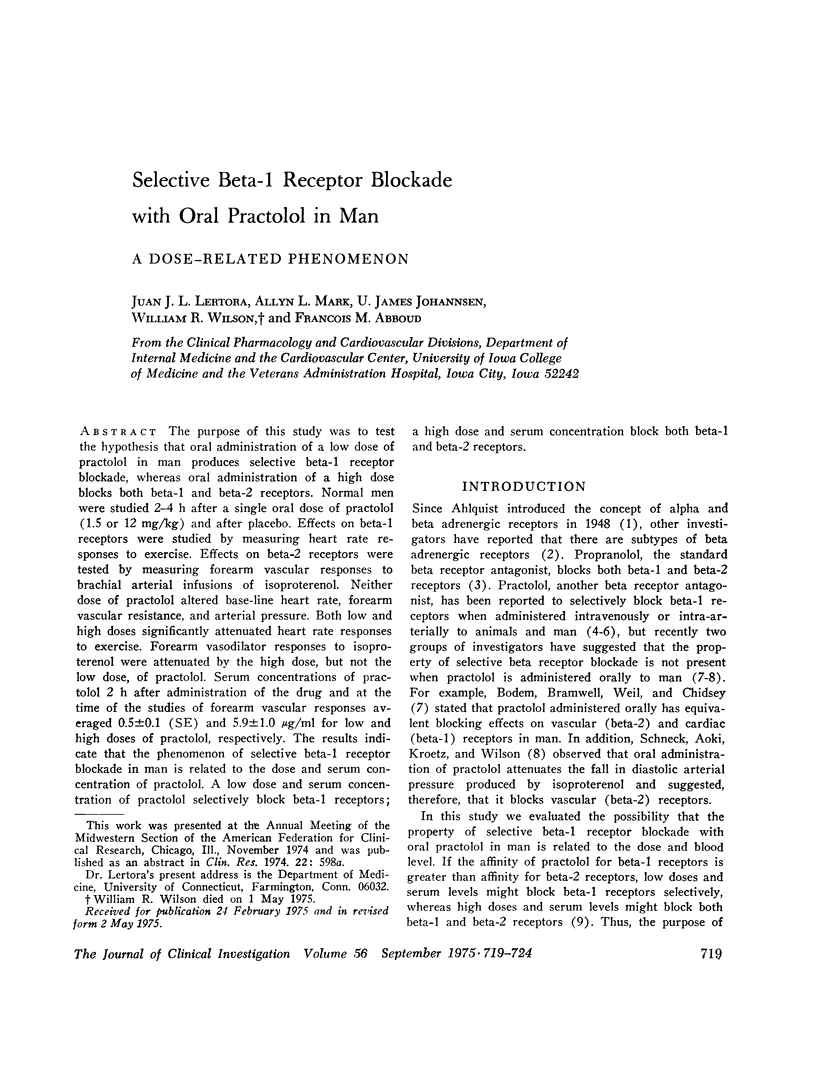
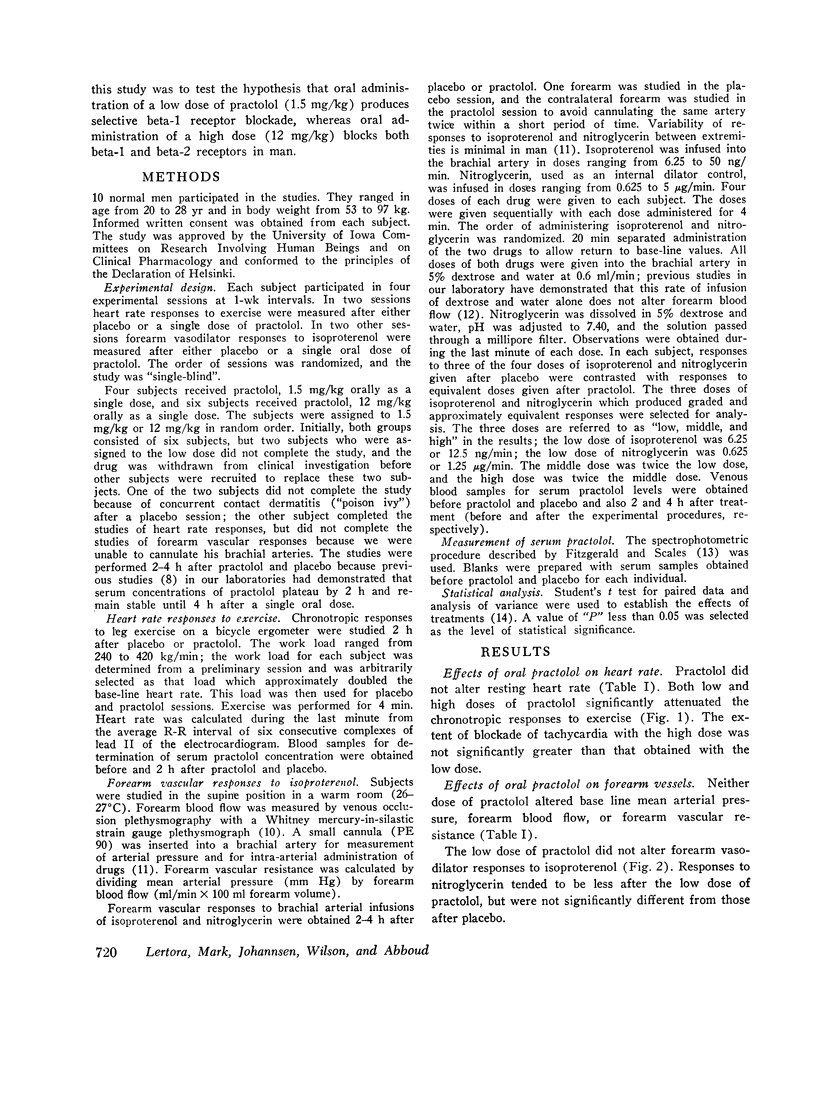

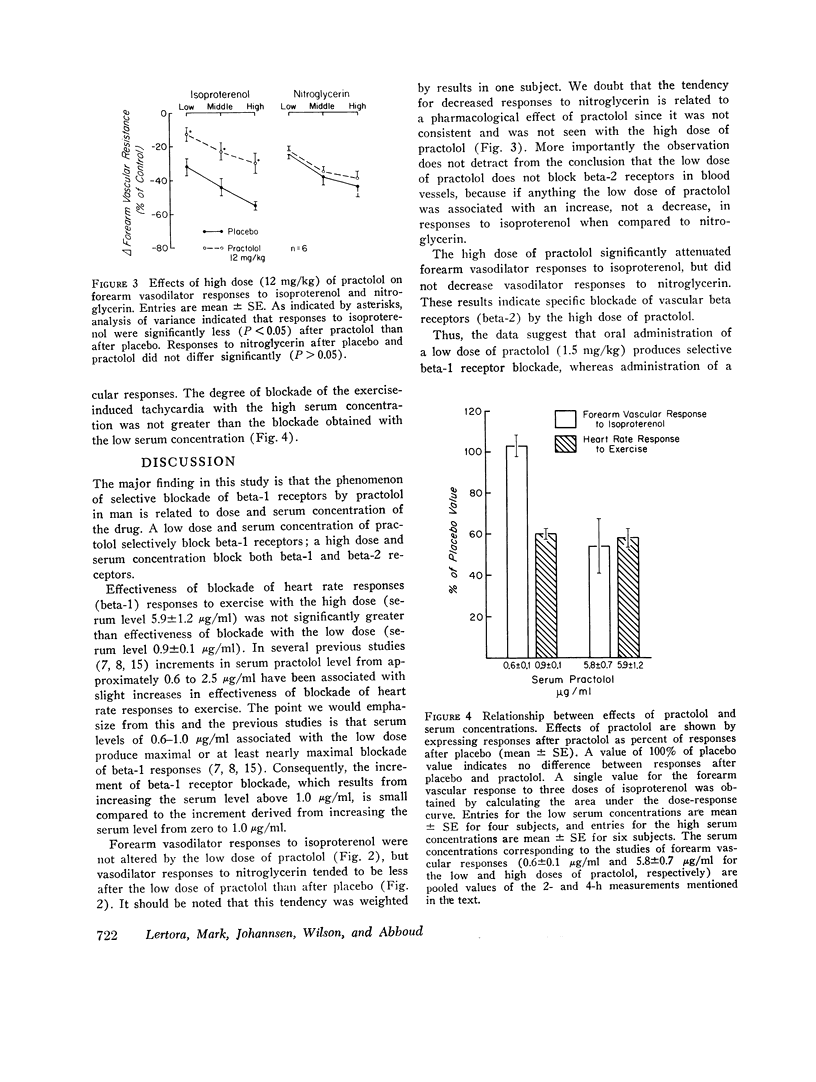
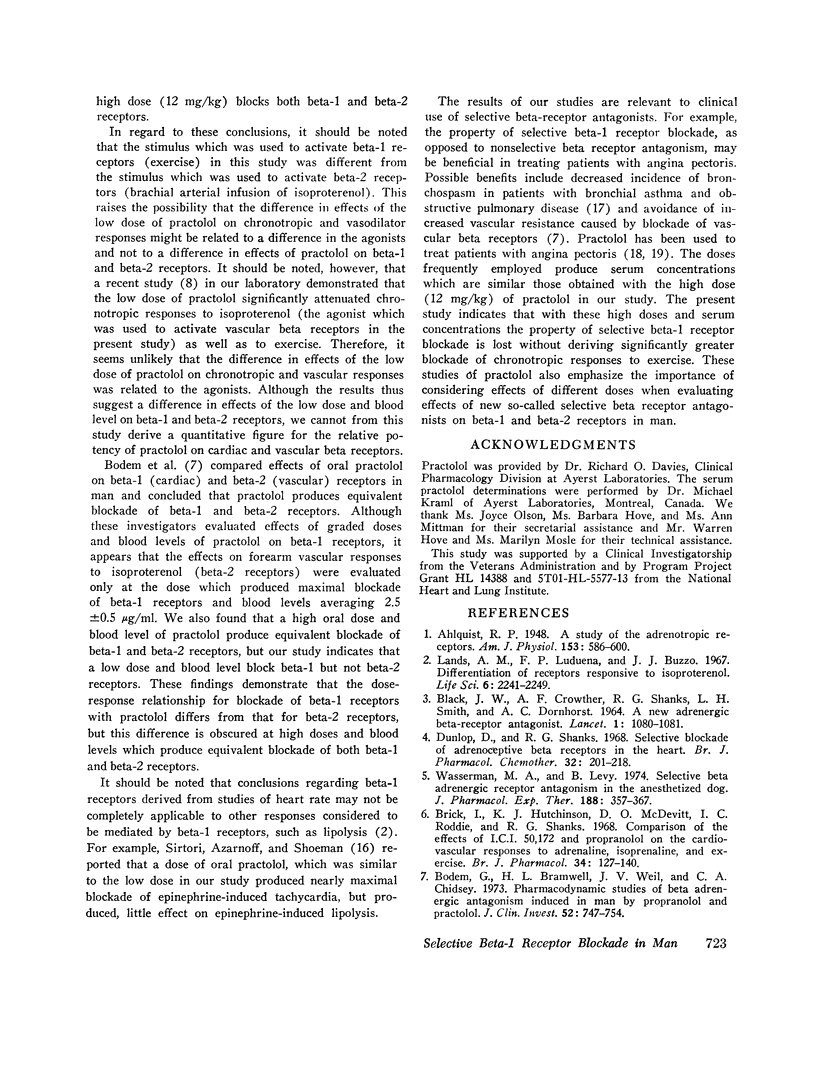
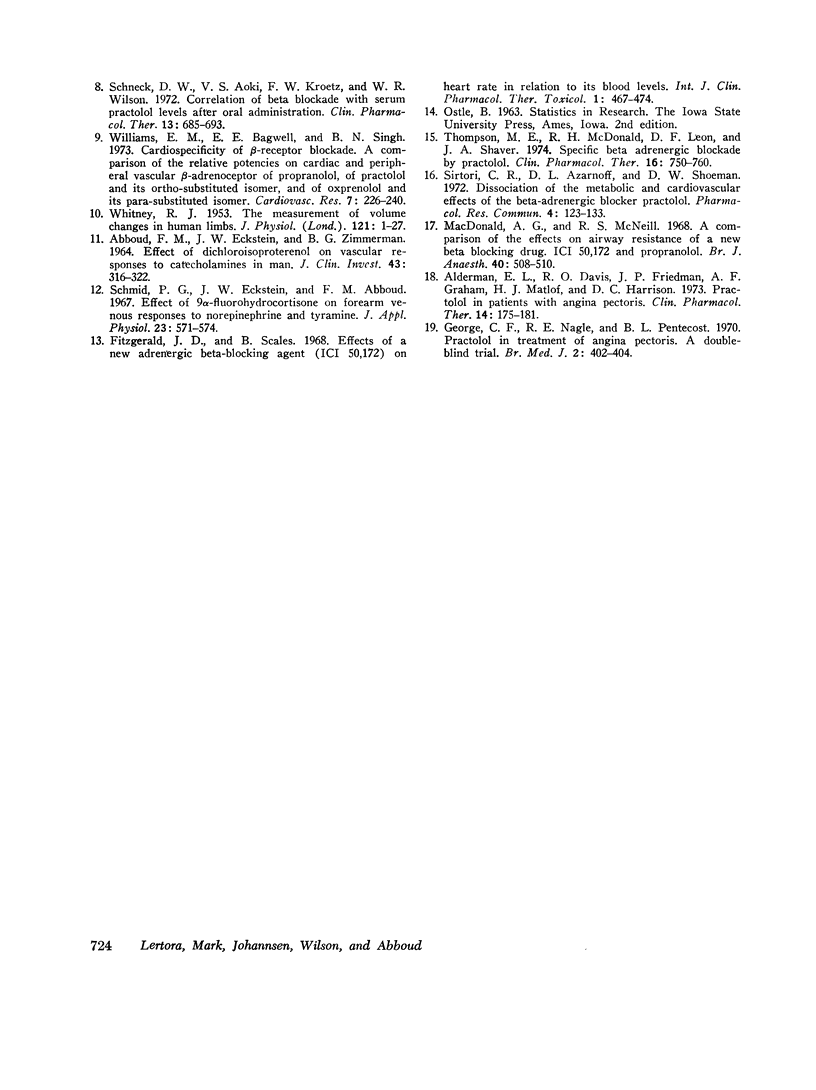
Selected References
These references are in PubMed. This may not be the complete list of references from this article.
- ABBOUD F. M., ECKSTEIN J. W., ZIMMERMAN B. G. EFFECT OF DICHLOROISOPROTERENOL ON VASCULAR RESPONSES TO CATECHOLAMINES IN MAN. J Clin Invest. 1964 Feb;43:316–322. doi: 10.1172/JCI104916. [DOI] [PMC free article] [PubMed] [Google Scholar]
- Alderman E. L., Davis R. O., Friedman J. P., Graham A. F., Matlof H. J., Harrison D. C. Practolol in patients with angina pectoris. Clin Pharmacol Ther. 1973 Mar-Apr;14(2):175–181. doi: 10.1002/cpt1973142175. [DOI] [PubMed] [Google Scholar]
- BLACK J. W., CROWTHER A. F., SHANKS R. G., SMITH L. H., DORNHORST A. C. A NEW ADRENERGIC BETARECEPTOR ANTAGONIST. Lancet. 1964 May 16;1(7342):1080–1081. doi: 10.1016/s0140-6736(64)91275-9. [DOI] [PubMed] [Google Scholar]
- Bodem G., Brammell H. L., Weil J. V., Chidsey C. A. Pharmacodynamic studies of beta adrenergic antagonism induced in man by propranolol and practolol. J Clin Invest. 1973 Apr;52(4):747–754. doi: 10.1172/JCI107237. [DOI] [PMC free article] [PubMed] [Google Scholar]
- Brick I., Hutchison K. J., McDevitt D. G., Roddie I. C., Shanks R. G. Comparison of the effects of I.C.I. 50172 and propranolol on the cardiovascular responses to adrenaline, isoprenaline and exercise. Br J Pharmacol. 1968 Sep;34(1):127–140. doi: 10.1111/j.1476-5381.1968.tb07956.x. [DOI] [PMC free article] [PubMed] [Google Scholar]
- Dunlop D., Shanks R. G. Selective blockade of adrenoceptive beta receptors in the heart. Br J Pharmacol Chemother. 1968 Jan;32(1):201–218. doi: 10.1111/j.1476-5381.1968.tb00444.x. [DOI] [PMC free article] [PubMed] [Google Scholar]
- Fitzgerald J. D., Scales B. Effect of a new adrenergic beta-blocking agent (ICI 50,172) on heart rate in relation to its blood levels. Int Z Klin Pharmakol Ther Toxikol. 1968;1(6):467–474. [PubMed] [Google Scholar]
- George C. F., Nagle R. E., Pentecost B. L. Practolol in treatment of angina pectoris. A double-blind trial. Br Med J. 1970 May 16;2(5706):402–404. doi: 10.1136/bmj.2.5706.402. [DOI] [PMC free article] [PubMed] [Google Scholar]
- Lands A. M., Luduena F. P., Buzzo H. J. Differentiation of receptors responsive to isoproterenol. Life Sci. 1967 Nov 1;6(21):2241–2249. doi: 10.1016/0024-3205(67)90031-8. [DOI] [PubMed] [Google Scholar]
- Macdonald A. G., McNeill R. S. A comparison of the effect on airway resistance of a new beta blocking drug, ICI.50,172 and propranolol. Br J Anaesth. 1968 Jul;40(7):508–510. doi: 10.1093/bja/40.7.508. [DOI] [PubMed] [Google Scholar]
- Schmid P. G., Eckstein J. W., Abboud F. M. Effect of 9-alpha-fluorohydrocortisone on forearm venous responses to norepinephrine and tyramine. J Appl Physiol. 1967 Oct;23(4):571–574. doi: 10.1152/jappl.1967.23.4.571. [DOI] [PubMed] [Google Scholar]
- Schneck D. W., Aoki V. S., Kroetz F. W., Wilson W. R. Correlation of beta blockade with serum practolol levels after oral administration. Clin Pharmacol Ther. 1972 Sep-Oct;13(5):685–693. doi: 10.1002/cpt1972135part1685. [DOI] [PubMed] [Google Scholar]
- Thompson M. E., McDonald R. H., Leon D. F., Shaver J. A. Specific beta adrenergic blockade by practolol. Clin Pharmacol Ther. 1974 Nov;16(5 Pt 1):750–760. doi: 10.1002/cpt1974165part1750. [DOI] [PubMed] [Google Scholar]
- WHITNEY R. J. The measurement of volume changes in human limbs. J Physiol. 1953 Jul;121(1):1–27. doi: 10.1113/jphysiol.1953.sp004926. [DOI] [PMC free article] [PubMed] [Google Scholar]
- Wasserman M. A., Levy B. Selective beta adrenergic receptor antagonism in the anesthetized dog. J Pharmacol Exp Ther. 1974 Feb;188(2):357–367. [PubMed] [Google Scholar]
- Williams E. M., Bagwell E. E., Singh B. N. Cardiospecificity of -receptor blockade. A comparison of the relative potencies on cardiac and peripheral vascular -adrenoceptors of propranolol, of practolol and its ortho-substituted isomer, and of oxprenolol and its para-substituted isomer. Cardiovasc Res. 1973 Mar;7(2):226–240. doi: 10.1093/cvr/7.2.226. [DOI] [PubMed] [Google Scholar]


